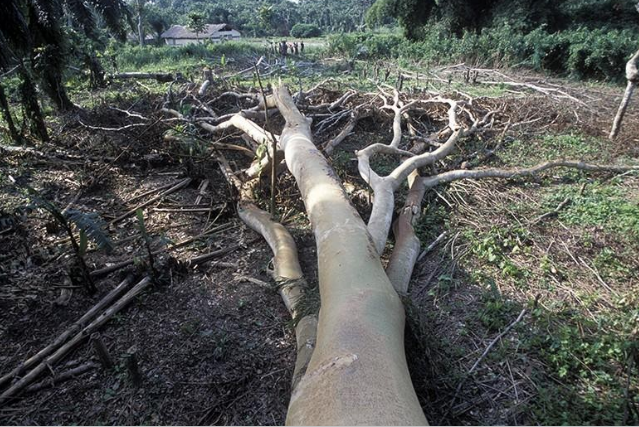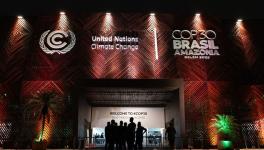Brazilian Amazon Destruction Heightens in Bolsonaro Regime Even as Links of Pandemic Risk to Deforestation Evident

Image Courtesy: Nature.com
The Amazon rainforest in Brazil is under great threat. Ever since Jair Bolsonaro took charge as the president of Brazil, the destruction of Amazon has increased. As per the latest report produced by Brazil’s National Institute of Space Research (INPE), Brazilian Amazon has seen a deforestation increase by about 34.5% between August 2019 and July 2020. INPE monitors the forest with the help of a satellite system known as Real Time Deforestation Detection System (DETER).
Primary forest cover of the Amazon amounting more than 8,700 square kilometres has disappeared according to DETER data updated by July 23. This massive deforestation happened since August 2019 and is the highest compared to 6,800 square kilometres of forest loss in the previous 12 months.
Jair Bolsonaro, as he promised during his election campaign, has left no stone unturned to give an open hand to private companies to extract mining, natural resources and setting up their outfits in the Amazon region. Last year, when the alarming rate of deforestation was captured by DETER, Bolsonaro even termed the DETER estimation a lie. Not only that he showed his authoritarian aggressive attitude and went ahead with firing Ricardo Galvao, the director of INPE. Bolsonaro’s argument was that DETER is not an optimised system for precise measurements, but scientists say that it is still a good barometer to judge deforestation. Later, another estimation from INPE itself through Amazon Deforestation Satellite Monitoring Project having a higher resolution than the DETER brought out data of Brazilian Amazon deforestation that was even worse than what was given by DETER.
This rate of destruction of the rainforest rings an alarm bell for the future, an alarm for biodiversity, environmental crisis and also a life-threatening situation for the indigenous people who depend on the forest for their livelihoods and also their culture.
Not only Amazon, increase in deforestation worldwide itself is a cause of deep concern. It is redundant to count the effects of deforestation. But in the middle of a pandemic what is more concerning is the link of deforestation to zoonotic outbreaks and pandemics.
The crucial relation among biodiversity, deforestation, land use and emerging zoonotic diseases with potential of causing a pandemic has long been talked about, but unfortunately it has been at the peripheries. But, the unprecedented challenges that the COVID-19 pandemic has unleashed have brought this topic into centre stage recently.
One such research, published on August 5 in Nature, analysed 6,800 ecological communities from six continents in 376 host species and concluded that land use and biodiversity loss has a global and systematic effect on the zoonotic host communities. The study was led by Kate Jones of University College, London. The researchers compiled over 3.2 million records of many different ecological studies already done at different sites of the world that comprise native forests to cropland to cities. Their analysis revealed that populations of species that can host diseases which are transmissible to humans increase when a landscape changes from natural to urban and concomitantly biodiversity decreases. The species able to host diseases include 143 mammals like that of bats, rodents along with various primates.
Jones’ group has previously evaluated the likelihood of the disease transmission to humans and proved successful in the case of mapping Ebola outbreak. In that case, they created risk maps that were based on development trend along with presence of host species and the socio-economic factors that could bolster the pace at which a virus could spread once it is in human population. Their estimation successfully predicted where Ebola outbreak could happen in the Democratic Republic of Congo (DRC). This suggests that it is possible to map the probable locations where a new outbreak could occur in the near future. More importantly, it is related to human activities and its impact on the ecology.
In September this year, there is a scheduled summit of the UN where governments are likely to pen down new norms of commitments to preserve biodiversity. The Inter-Governmental Science Policy Platform on Biodiversity and Ecosystem Services (IPBES) last week organised a workshop on biodiversity loss and disease emergence. The organisation aims to offer an expert assessment on it before the UN summit.
On July 24, in an essay titled “Ecology and economics for pandemic prevention”, a group of virologists, economists and ecologists argued that governments can have an important role in curbing deforestations and wildlife trade, and pave a way for reducing the possibilities of future pandemics.
The recent past of SARS and bird influenza outbreaks also suggested that viruses causing these diseases spilled over from other animals to humans in an increased frequency in past few decades. This has a direct link to increased human activities that has led to more and more deforestations. One key question in this regard is whether the loss of biodiversity increases the chance of pathogens jumping to humans? The work of Jones and others suggest that it is true in many instances. As biodiversity is lost, few species replace many and chance of these species hosting the pathogens increases, and as a result, the spillover of the pathogens to humans also becomes frequent.
But, to have a holistic approach on this crucial issue will have to incorporate the economic and cultural factors of the people that depend on forests for their livelihoods. Merely saying biodiversity conservation and overlooking the economic and other factors will lead us nowhere. Ibrahima Soce Fall, epidemiologist and head of emergency operation of WHO said—“Sustainable development is crucial. If we continue to have this level of deforestation, disorganised mining and unplanned development, we are going to have more outbreaks.” This resonates the need for an approach where ecology and socio-economic factors in the rural frontier is crucial for future outbreak management.
However, all the scientific findings, warnings and proposals will have some meaning if leaders like Bolsonaro understand the gravity of the problem and have some patience. Governments across the world will have to arrive at some commitment and work out a policy formulation for an alternate model of development. But, previous experiments on climate control commitments have not been made good, right from the Kyoto protocol to the Paris Agreement, in which one of the largest greenhouse gas producer, the US walked out abruptly under the Trump regime.
Get the latest reports & analysis with people's perspective on Protests, movements & deep analytical videos, discussions of the current affairs in your Telegram app. Subscribe to NewsClick's Telegram channel & get Real-Time updates on stories, as they get published on our website.
























